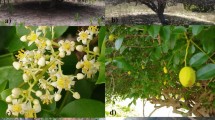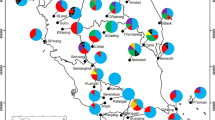Abstract
Because some endemic plants appear to be adapted to a narrow setof environmental conditions with limited genetic diversity, an analysis ofpopulation genetic structure is necessary to fully evaluate the impact of rarityon genetic variation. Listed as endangered species in Korea, only fewpopulations of Abeliophyllum distichum, Leonticemicrorhyncha, Bupleurum euphorbioides, andBerchemia berchmiaefolia were found. A reduced level ofgenetic variation in B. berchemiaefolia is consistent withthe occurrence of a genetic bottleneck and inbreeding. Leonticemicrorhyncha differed dramatically from other taxa in its observed level of geneticvariation, probably due to its predominant selfing. The level ofallozyme variation maintained by A. distichum was high forendemic species. Compared to species with similar traits, A.distichum maintained a relatively higher genetic diversity, probably dueto floral heteromorphism and preferred outcrossing. Bupleurumeuphorbioides maintained a higher genetic diversity due to outcrossing,but at the individual locus, deficiency of heterozygosity prevailed. Probablyinbreeding between local neighborhoods was frequent because A.distichum and B. euphorbioides were pollinatedby small fly species which might be less effective as a pollen dispersal, andtheir visits were extremely scarce and controlled by the weather conditions.Since much of the species-to-species variation in genetic diversity is due tothe specific ecological and evolutionary history of a species, any managementplan developed should be based on historical changes in the population size anddistribution to better predict the amounts and patterns of genetic diversity.
Similar content being viewed by others
References
Barrett S.C.H. and Kohn J.R. 1991. Genetic and evolutionary consequences of small population size in plants: implications for conservation. In: Falk D.A. and Holsinger K.E. (eds), Genetics and Conservation of Rare Plants. Oxford University Press, New York, pp. 3–30.
Baskauf C.J., McCauley D.E. and Eickmeier W.G. 1994. Genetic analysis of a rare and a widespread species of Echinacea (Asteraceae). Evolution 48: 180–188.
Chang C.S., Kim H. and Kim Y.S. 2001. Reconsideration of rare and endangered plant species in Korea based on the IUCN Red List Categories. Korean Journal of Plant Taxonomy 31 (in Korean): 107–142.
Conkle M.T., Hodgskii P.D., Nunnally L.B. and Hunter S.C. 1982. Starch gel electrophoresis of conifer seeds: a laboratory manual. Technical Report PSW-64. USDA, Forest Service Pacific Southwest and Range Experiment Station, Berkely, California.
Ellstrand N.C. and Elam D.R. 1993. Population genetic consequences of small population size; implications for plant conservation. Annual Review of Ecology and Systematics 24: 217–242.
Godt M.W. and Hamrick J.L. 1996. Genetic structure of two endangered pitcher plants, Sarracenia jonesii and Sarracenia oreophila (Sarracebuaceae). American Journal of Botany 83: 1016–1023.
Godt M.W. and Hamrick J.L. 1998. Allozyme diversity in the endangered pitcher plant, Sarracenia rubra ssp. alabamensis (Sarracebuaceae) and its close relative S. rubra ssp. rubra. American Journal of Botany 85: 802–810.
Hamrick J.L. and Godt M.J. 1989. Allozyme diversity in plant species. In: Brown A.H.D., Clegg M.T., Kahler A.L. and Weir B.S. (eds), Plant Population Genetics, Breeding and Genetic Resources. Sinauer, Sunderland, Massachusetts, pp. 43–63.
Hamrick J.L. and Godt M.J.W. 1996. Conservation genetics of endemic plant species. In: Avis J.C. and Hamrick J.L. (eds), Conservation Genetics; Case Histories from Nature. Chapman & Hall, New York, pp. 281–304.
Holsinger K.E. and Gottlieb L.D. 1991. Conservation of rare and endangered plants: principles and prospects. In: Falk D.A. and Holsinger K.E. (eds), Genetics and Conservation of Rare Plants. Oxford University Press, New York, pp. 195–208.
Kang S.J., Kim H.E. and Lee C.S. 1991. Ecological studies on the distribution, structure and maintenance mechanism of Berchemia berchemiaefolia forest. Korean Journal of Ecology 14 (in Korean): 25–38.
Kang U., Chang C.S. and Kim Y.S. 2000. Genetic structure of endemic Abeliophyllum distichum Nakai in Korea. Journal of Plant Research 113: 127–138.
Kim H. 1996. Population demography, genetic diversity and conservation of a rare species Bupleurum euphorbioides Nakai in Mt. Sorak, M.Sc. Thesis, Seoul National University, Seoul, South Korea (in Korean with English abstract).
Kim T.H. and Han M.J. 1998. The reproductive system of the Korean endemic taxon, Abeliophyllum distichum Nakai, a distylous species (Oleaceae), B.Sc. Thesis, Kyung Hee University, Seoul, South Korea (in Korean with English abstract).
Kim Y.S. and Maunder M. 1998. Plants in peril, 24 Abeliophyllum distichum. Curtis's Botanical Magazine 15: 141–146.
Kong W. 1989. The biogeographic divisions of Korea and their past and present environments with special reference to Arctic-Alpine and Alpine Flora, Ph.D. Thesis, The University of Hull, Hull, UK.
Lacy R.C. 1987. Loss of genetic diversity from managed populations: interacting effects of drift, mutation, immigration, selection, and population subdivision. Conservation Biology 1: 143–158.
Lee T.B. 1979. Distribution of Berchemia bechemiaefolia and an investigation for its conservation in Korea. Korean Journal of Plant Taxonomy 9 (in Korean): 1–6.
Lee Y.M. and Lee W.Y. 1996. Illustrated Rare and Endangered Species in Korea. The Life of Tree Comp., Seoul (in Korean).
Li C.C. and Horvitz D.G. 1953. Some methods of estimating the inbreeding coefficient. American Journal of Human Genetics 5: 107–117.
Lutz E., Schneller J.J. and Holderegger R. 2000. Understanding population history for conservation purposes: population genetics of Saxifraga aizoides (Saxifragaceae) in the lowlands and lower mountains north of the Alps. Am. J. Bot. 87: 583–590.
Nei M. 1978. Estimation of average heterogeneity and genetic distance for a small number of individuals. Genetics 89: 583–590.
Ohwi J. 1984. Flora of Japan. Smithsonian Institute, Washington, DC.
Pavlik B. 1994. Demographic monitoring and the recovery of endangered plant populations. In: Bowles M.L. and Whelan C.J. (eds), Restoration of Endangered Species. Cambridge University Press, Cambridge, UK, pp. 322–350.
Polans N.O. and Allard R.W. 1989. An experimental evaluation of the recovery potential of rye grass populations from genetic stress resulting from restriction of population size. Evolution 43: 1320–1324.
Ryu T.Y., Yeam D.Y., Kim Y.J. and Kim S.J. 1976. Studies on heterostyly incompatibility of Abeliophyllum distichum. Seoul National University College of Agriculture Bulletin 1: 113–120.
Soltis D.E., Haupler C.H., Darrow D.C. and Gastony G.J. 1983. Starch gel electrophoresis of ferns: a compilation of grinding buffers, gel and electrode buffers and staining schedules. American Fern Journal 73: 9–27.
Swofford D.E. and Selander R.B. 1981. BIOSYS-1: a FORTRAN program for the comprehensive analysis of electrophoretic data in population genetics and systematics. Journal of Heredity 72: 281–283.
Templeton A.R. 1991. Off-site breeding of animals and implications for plant conservation strategies. In: Falk D.A. and Holsinger K.E. (eds), Genetics and Conservation of Rare Plants. Oxford University Press, New York, pp. 182–194.
Van Treuren R., Bulsma R., Oubourg N.J. and van Delden W. 1993. The significance of genetic erosion in the process of extinction. IV. Inbreeding depression and heterosis effects caused by selfing and outcrossing in Scabiosa columbaria. Evolution 47: 1669–1680.
Weller S.G. 1994. The relationship of rarity to plant reproductive biology. In: Bowles M.L. and Whelan C.J. (eds), Restoration of Endangered Species. Cambridge University Press, Cambridge, UK, pp. 90–117.
Weller S.G., Sakai A.K. and Straub C. 1996. Allozyme diversity and identity in Schiedea and Alsinidendron (Caryophyllaceae: Alsinoideae) in the Hawaiian Islands. Evolution 50: 22–34.
Wendel J.F. and Weeden N.F. 1989. Visualization and interpretation plant isozymes. In: Soltis D. and Soltis P. (eds), Isozymes in Plant Biology. Dioscorides Press, Portland, Oregon, pp. 5–45.
Wright S. 1931. Evolution in Mendelian populations. Genetics 16: 97–159.
Wyatt R.E., Evans A.J. and Sorenson C. 1992. The evolution of self-pollination in granite outcrop species of Arenaria (Caryophyllaceae). VI. Electrophoretically detectable genetic variation. Systematic Botany 17: 201–209.
Rights and permissions
About this article
Cite this article
Chang, CS., Kim, H. & Park, TY. Patterns of allozyme diversity in several selected rare species in Korea and implications for conservation. Biodiversity and Conservation 12, 529–544 (2003). https://doi.org/10.1023/A:1022424918477
Issue Date:
DOI: https://doi.org/10.1023/A:1022424918477




